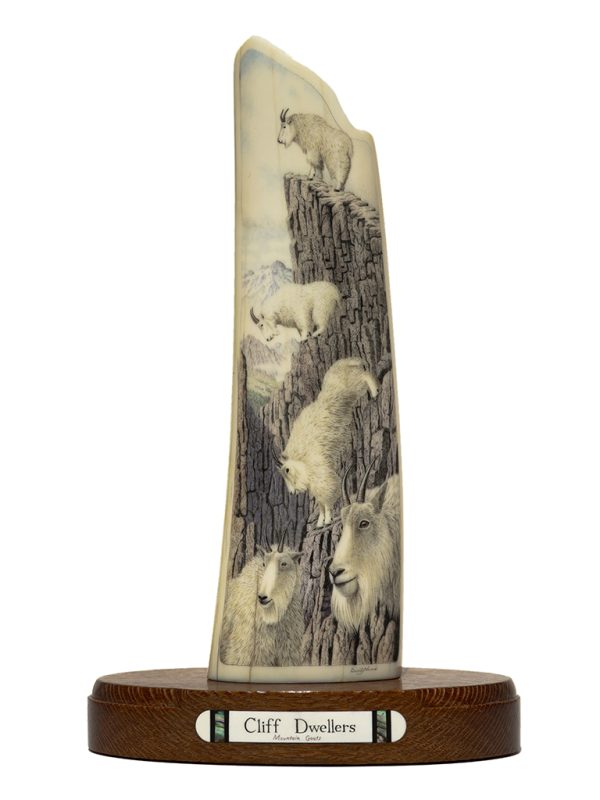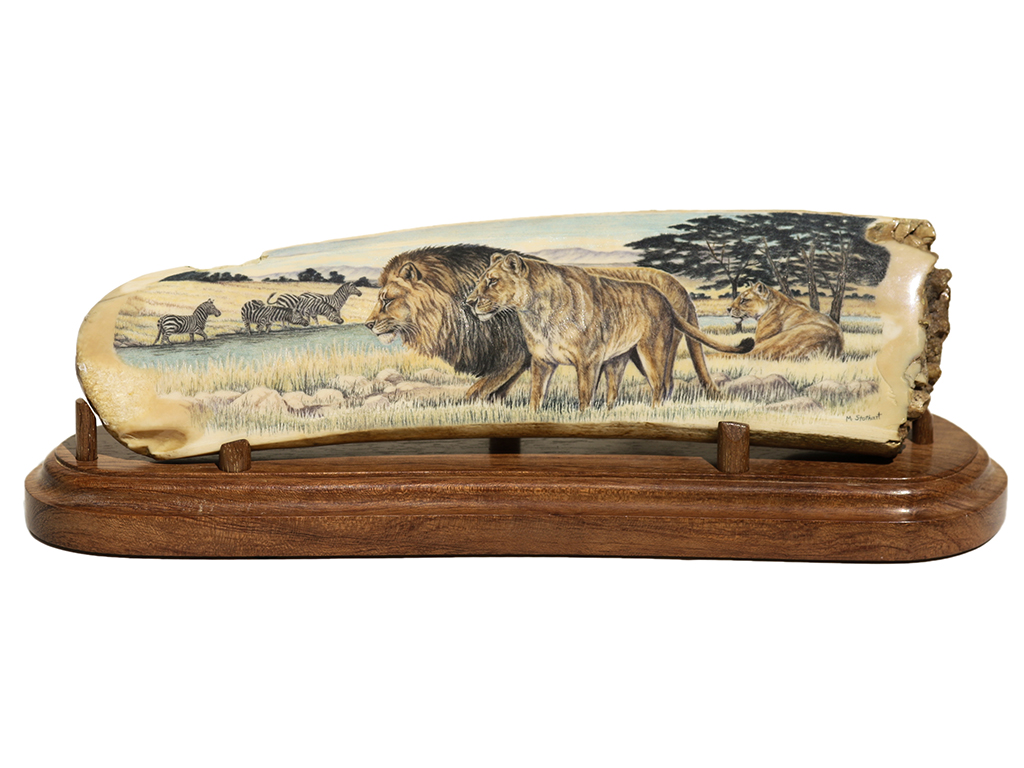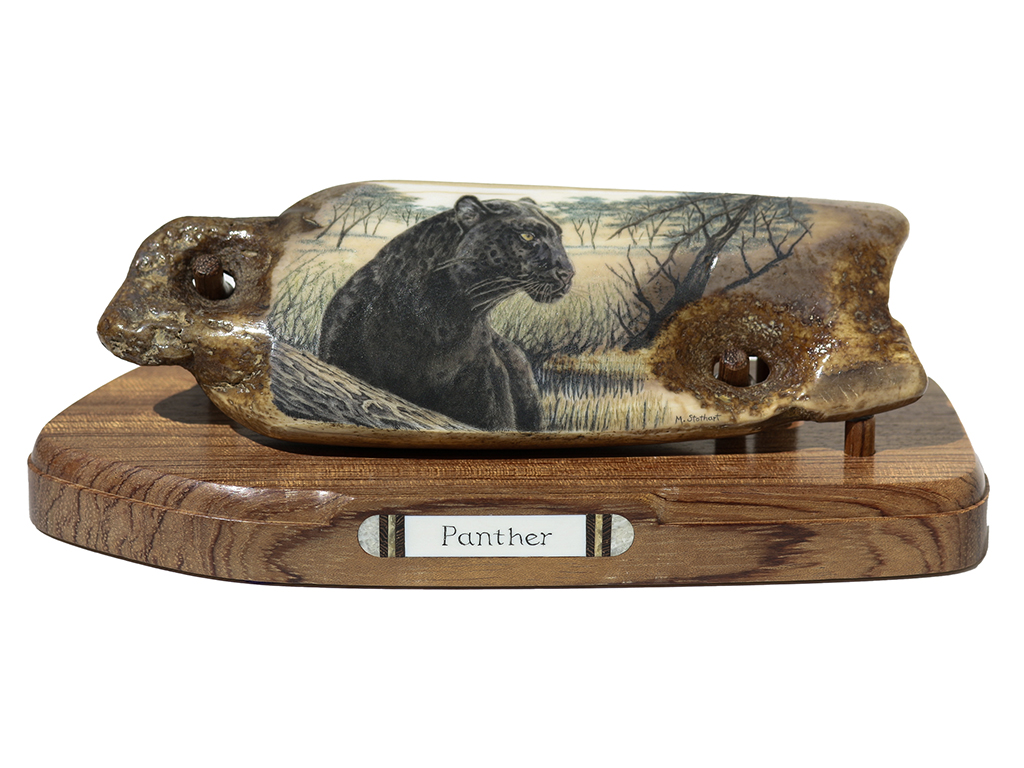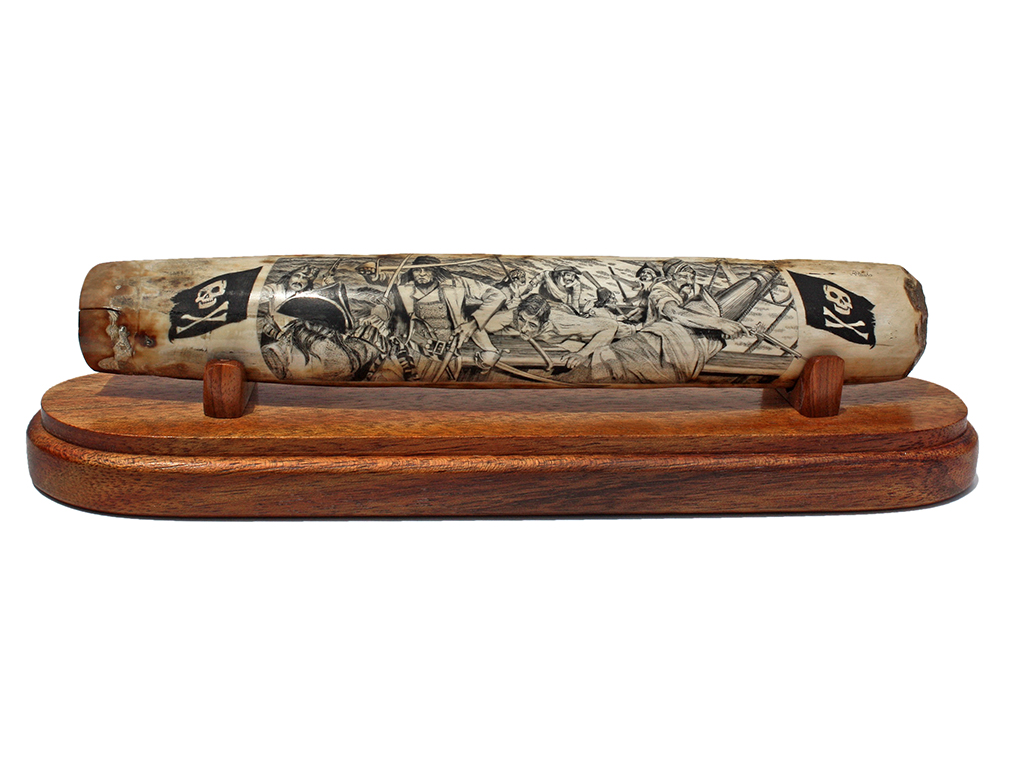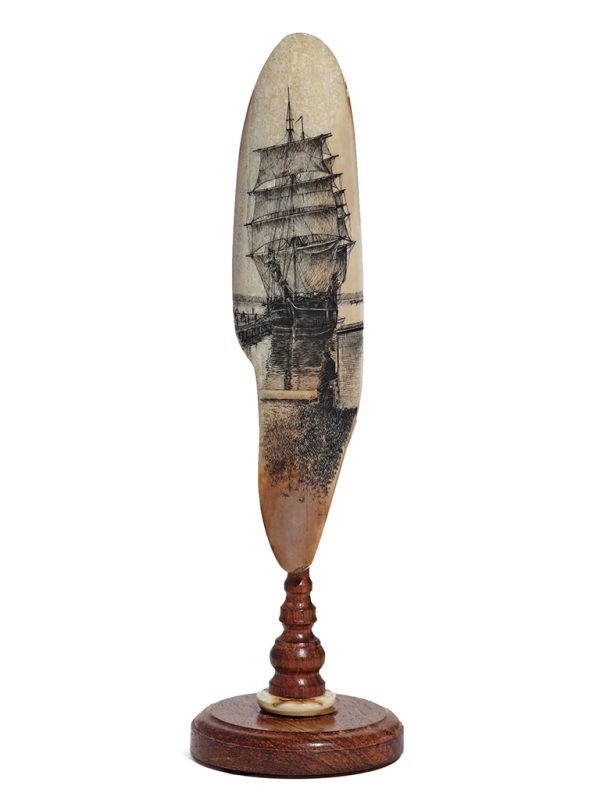“First Contact” black and white scrimshaw on ancient walrus tusk artifact by Gregg Olson. Amazing artifact used as a sled runner on the sleds of people in the Northern Bering Sea hundreds and hundreds of years ago. At some point it appears to have been subjected to fire. As can be seen, the underside is completely black and charred. It is unbelievable that enough ivory remained on the other side to enable Olson to create this unique scene. The scrimshander has chosen to divide the surface into three separate panels: (Eskimo Pictograph, First Contact and 18th Century Map) all of which tell a story. This is from the collection of one of our clients who is no longer with us. His estate requested us to price it to move, which we have done. This could easily be priced at $2800.00. Good deal here for someone.
“China Tea Clipper” black and white scrimshaw on large cross cut piece of ancient walrus tusk ivory. Framed work would look nice hanging on a wall or set in an easel on a collector’s desk. Created by Williams 1988 when he was working in Maui. Later he moved to the Bay Area and did many, many pieces for Scrimshaw Gallery. This is from one of our collectors who is no longer with us (ditto Williams) who probably got it in Maui. By the way, this is cross cut came from a very large ancient walrus tusk. Not many that size around today. Excellent opportunity to add a vintage Williams work to one’s collection at 1988 prices.
“Cliff Dwellers” mainly black and white scrimshaw on ancient walrus tusk ivory by David Adams. Amazing composition by Adams on this one. Perfect subject matter for the size and shape of the ivory.The way the tip of the tusk was broken off years and years ago gives the impression of a mountain top. Mounted on a stunning R. Cash lacewood stand, this would be a welcome addition to any serious scrimshaw collection.
Taken from the internet:
The mountain goat, also known as the Rocky Mountain goat, is a cloven-footed mammal that is endemic to the remote and rugged mountainous areas of western North America. A subalpine to truly alpine species, it is a sure-footed climber commonly seen on sheer rock faces, near-vertical cliffs and icy passages.
“Serengeti Scene” color scrimshaw on ancient walrus tusk ivory artifact by Matt Stothart. Veteran scrimshander, Stothart, always creates stunning work, as can be seen here. This is a very large artifact that was used as an ice axe hundreds of years ago by people in the Northern Bering Sea area. It is in museum condition and quite heavy (1 lb., 14.9 oz.)! Mounted on a classic Cash bubinga stand, this is a rare work, indeed. There is very little of this quality of artifact ivory around today. It is from the collection of one of our clients who is no longer with us and had an extensive collection. The word “Serengeti” comes from the Maasai language and translates to “endless plains” or “a place where the land runs forever”.
“King of the Serengeti” color scrimshaw on ancient walrus tusk ivory artifact by Gary Dorning. Considered to be the very best wildlife scrimshander ever, Dorning’s work is prized by collectors far and wide. The ivory was used as a ice axe by people in the Northern Bering Sea area hundreds of years ago. The word “Serengeti” is taken from the Maasai language and translates to “endless plains” or “a place where the land runs forever”. Dorning has captured that feeling with this amazing work. Not a great deal of Dorning’s work comes up for sale and most collectors are loath to part with his work. This is from the collection of one of our clients who is no longer with. He added this piece to his extensive collections decades ago, which is why the price is so reasonable for a Dorning.
“African Black Panther” color scrimshaw on ancient walrus tusk ivory artifact by Matt Stothart. Ivory used as a net sinker by people in the Northern Bering Sea area hundreds and hundreds of years ago. Beautiful bubinga stand created by Cash is a work of art in itself. This magnificent animal looks like he is just taking his time in the shade, resting behind a tree limb. Excellent work by Stothart/Cash on this keeper. From the extensive collection of one of our clients who is no longer with us. Really like this one.
Taken from the internet: A black panther is the melanistic colour variant of the leopard (Panthera pardus) and the jaguar (Panthera onca). Black panthers of both species have excess black pigments, but their typical rosettes are also present. They have been documented mostly in tropical forests, with black leopards in Africa and Asia, and black jaguars in Central and South America. Melanism is caused by a recessive allele in the leopard, and by a dominant allele in the jaguar.
“Autumn Wolf” color scrimshaw on ancient walrus tusk ivory by David Adams. Fall foliage still on the trees after an early light snowfall. Have to admire the way scrimshander Adams, composes his works. Interesting addition of a partially hidden wolf at the bottom. First class work by Adams, as always. One of the very best working today, no doubt about it.
“Pirates Boarding!” black and white scrimshaw on ancient walrus tusk ivory artifact by Jim Pauls. The only pirate scene we have ever seen from Pauls. From the collection of one of our clients who is no longer with us. Interesting artifact used as a sled runner by people in the Northern Bering Sea area. A ton of action in this one. Looks like the pirates will board, but no one knows the final outcome. Rare piece, indeed.
“Whaler Drying Sails” black and white scrimshaw on ancient walrus tusk ivory artifact by Gerry Dupont. Peaceful depiction of drying sails by returning whaler. Several people, with nothing else to do, walk along the dock. An old salt sits alone, remembering his past voyages. Award winning scrimshander, Dupont, really tells a story with this gem. Walrus tusk was used as some sort of scraper or digging tool hundreds of years ago in the Northern Bering Sea area. Fine work here.
“Close Quarters Battle” black and white scrimshaw on ancient walrus tusk ivory artifact by Steve Willeford. Powerful work by Willeford on this one, The scene is below deck in one of the British battleships. One can only imagine the noise, smoke and utter fear that the men must have experienced. This was done on an ancient walrus tusk that was used as a net sinker for the people in the Northern Bering Sea area. Willeford was one of the very few who ever attempted these type of scenes by depicting the actual sailors up close. Other battle scenes featured complete ships firing broadsides at each other. This is from the collection of one of our clients who is no longer with us. Steve did not produce a great volume of work, so this is quite rare. Fine addition to a nautical collection.



